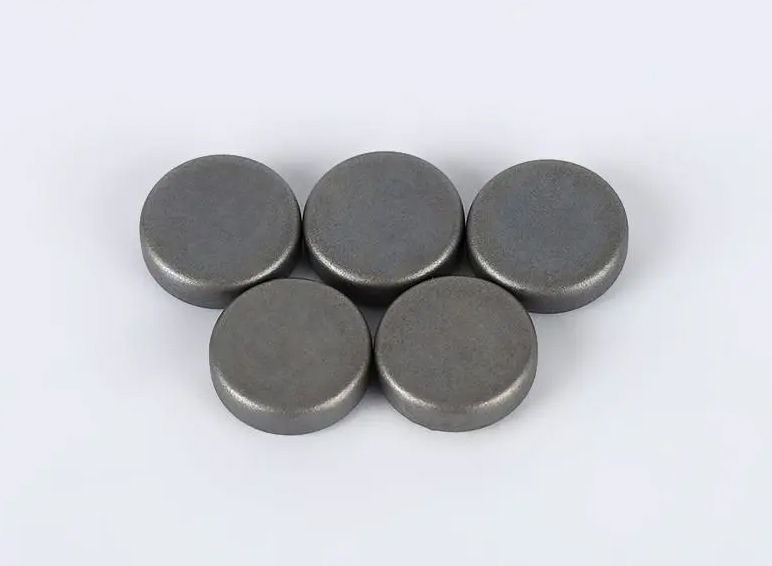The surface of Neodymium magnet is easy to be oxidized and corroded, usually the surface will be protected by a layer of plating, the common plating such as zinc plating and nickel plating, but there is an other special plating - phosphating coated. Let me introduce the knowledge about phosphating of NdFeB magnet.
Why choose phosphate plated? What is the purpose of photostatting treatment?
There are two purposes of photostatting surface treatment for sintered Neodymium permanent magnets, the first is to act as a process anti-corrosion and the second is to improve the surface epoxy wettability.
Phosphating coated round disc magnet

1. The process of corrosion prevention
Due to the low denseness and porosity of the sintered Neodymium iron boron surface, the exposed magnet will be oxidized in the air, which we also call corroded. Therefore, it is necessary and effective to use phosphating process for simple anti-corrosion treatment when the turnover and storage time of Neodymium magnet is too long and the subsequent surface treatment method is not clear.
Phosphating production process is simple, no require equipment investment. The production process of phosphating consumes less, mainly consisting of acid, alkali and phosphating liquid. The production cost is low. After phosphating, the color of the product is uniform and the surface is clean. Vacuum packaging can be used to greatly prolong the storage time. The storage method is better than the previous storage method of oil immersion and oil coating. The complete phosphating film can resist the oxidation corrosion of normal atmospheric environment. Subsequent surface treatment of phosphating magnet products is very easy. The phosphating film can be completely removed by simple pickling, which will not have adverse effects on subsequent surface treatment (such as zinc plating, nickel plating, etc.), and the subsequent surface treatment process can be completed at any time.
2. Improve the infiltration performance
Some iron boron magnets need epoxy, glue, bonding, painting, etc., glue, paint and other epoxy organic adhesion requires a very good infiltration performance of the substrate. Phosphating film and epoxide organic matter have good wetting properties, so it is necessary to use the chemical process to improve the surface wetting properties of chin-iron boron magnets. Good moist performance, can ensure the epoxy glue, epoxy paint and magnet binding force.
The principle of ndfeb phosphating and process flow:
Magnet surface phosphate treatment process is: oil removal - water washing - pickling - water washing - surface conditioning - phosphate treatment - closed drying
Degreasing pickling and electroplating pre-treatment is the same, table conditioning is the surface of NdFeB magnets to adapt to phosphate film generation of special surface treatment. NdFeB magnet surface conditioning generally uses weak acid immersion to improve the magnet surface alloy components, in order to achieve the purpose of phosphate film generation. Phosphating process is currently mainly used in the production of commercial phosphating solution. Commercial phosphating solution is divided into zinc, iron, manganese, binary, ternary, multi-species, each system has its own advantages and shortcomings, so the NdFeB phosphating production applications, the magnet manufacturers will be due to the purchase price, the use of different effects, the use of their own considered appropriate supply varieties. Some NdFeB products require phosphating after galvanizing, and phosphating after galvanizing should use zinc phosphating solution or multiple phosphating solution containing zinc.
Phosphating process in terms of temperature is divided into three types: high temperature, medium temperature, room temperature. High-temperature process is generally thick film layer, phosphate film density, thickness; room temperature process is generally thin film layer, medium temperature process between the two. Magnet manufacturers use more room temperature process, but room temperature process also requires temperature control to ensure temperature stability (15C-35°C)
The rust problem after phosphating:
Magnetic material in the phosphating have rust phenomenon, the causes of Magnetic material in the phosphating have rust phenomenon, this phenomenon are many, for example: phosphating pool in the phosphating agent concentration is not enough, resulting in the production of phosphate film is too thin or loose, can not be well isolated from the air, phosphating after washing is not clean, or washing pool is too acidic, resulting in acid residues on the magnetic material, acid damage phosphate film leads to rust, in addition to check whether the oil removal is thorough, oil removal Not clean will also affect the phosphating effect. To ensure the phosphating effect, the phosphating process requires special attention to the phosphating solution into the distribution ratio to ensure the appropriate temperature, phosphating time control in 10-15 minutes, the use of hanging or reduce the amount of loading, to ensure that there is a certain gap between the magnetic material, can be phosphated fully.
What are the advantages of neodymium magnet phosphating coating?
Anti-corrosion: magnet phosphating coating can effectively prevent oxidation and corrosion of metal surface, prolong its service life.
Lubrication: Magnet phosphating coating can form a layer of lubricating film on the metal surface, reduce friction and wear between metals, reduce noise and energy loss.
Surface modification: magnet phosphating coating can change the physical and chemical properties of the metal surface, so that it has better wear resistance, corrosion resistance, oxidation resistance and high temperature resistance.
Enhanced coating adhesion: magnet phosphating coating can improve the adhesion of the coating, making the coating more firm and durable.
Beautiful: magnet phosphating coating can make the metal surface appear beautiful black or dark gray, enhance its beauty and texture.
In general, magnet phosphating coating has many advantages such as corrosion prevention, lubrication, surface modification, enhancement of coating adhesion and aesthetics, so it is widely used in many industrial fields.
Thank you for reading our article. We hope it can help you better understand the phosphating treatment of NdFeb magnet surface. If you want to know more about magnet coating, you can contact us to buy magnets of this kind of coating!
Introduction to related magnet plating;
 China Courage Magnet Manufacturer
China Courage Magnet Manufacturer 



WeChat
Scan the QR Code with WeChat